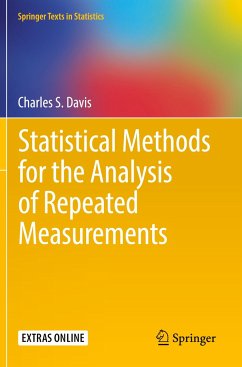
Statistical Analysis and Data Display
An Intermediate Course with Examples in R
Versandkostenfrei!
Versandfertig in 6-10 Tagen
122,99 €
inkl. MwSt.
Weitere Ausgaben:

PAYBACK Punkte
61 °P sammeln!
This contemporary presentation of statistical methods features extensive use of graphical displays for exploring data and for displaying the analysis. The authors demonstrate how to analyze data-showing code, graphics, and accompanying computer listings-for all the methods they cover. They emphasize how to construct and interpret graphs, discuss principles of graphical design, and show how accompanying traditional tabular results are used to confirm the visual impressions derived directly from the graphs. Many of the graphical formats are novel and appear here for the first time in print. All chapters have exercises.
The second edition features new chapters, sections and revisions. New chapters cover Likert Scale Data to build on the importance of rating scales in fields from population studies to psychometrics.
This book can serve as a standalone text for statistics majors at the master's level and for other quantitatively oriented disciplines at the doctoral level, and as a reference book for researchers. In-depth discussions of regression analysis, analysis of variance, and design of experiments are followed by introductions to analysis of discrete bivariate data, nonparametrics, logistic regression, and ARIMA time series modeling. The authors illustrate classical concepts and techniques with a variety of case studies using both newer graphical tools and traditional tabular displays.
The authors provide and discuss R and SAS executable functions and macros for all new graphical display formats. All graphs and tabular output in the book were constructed using these programs. Complete transcripts for all examples and figures are provided for readers to use as models for their own analyses.
The second edition features new chapters, sections and revisions. New chapters cover Likert Scale Data to build on the importance of rating scales in fields from population studies to psychometrics.
This book can serve as a standalone text for statistics majors at the master's level and for other quantitatively oriented disciplines at the doctoral level, and as a reference book for researchers. In-depth discussions of regression analysis, analysis of variance, and design of experiments are followed by introductions to analysis of discrete bivariate data, nonparametrics, logistic regression, and ARIMA time series modeling. The authors illustrate classical concepts and techniques with a variety of case studies using both newer graphical tools and traditional tabular displays.
The authors provide and discuss R and SAS executable functions and macros for all new graphical display formats. All graphs and tabular output in the book were constructed using these programs. Complete transcripts for all examples and figures are provided for readers to use as models for their own analyses.
This contemporary presentation of statistical methods features extensive use of graphical displays for exploring data and for displaying the analysis. The authors demonstrate how to analyze data-showing code, graphics, and accompanying tabular listings-for all the methods they cover. Complete R scripts for all examples and figures are provided for readers to use as models for their own analyses.
This book can serve as a standalone text for statistics majors at the master's level and for other quantitatively oriented disciplines at the doctoral level, and as a reference book for researchers. Classical concepts and techniques are illustrated with a variety of case studies using both newer graphical tools and traditional tabular displays.
New graphical material includes:
an expanded chapter on graphics
a section on graphing Likert Scale Data to build on the importance of rating scales in fields from population studies to psychometrics
a discussion on design of graphics that will work for readers with color-deficient vision
an expanded discussion on the design of multi-panel graphics
expanded and new sections in the discrete bivariate statistics capter on the use of mosaic plots for contingency tables including the n×2×2 tables for which the Mantel-Haenszel-Cochran test is appropriate
an interactive (using the shiny package) presentation of the graphics for the normal and t-tables that is introduced early and used in many chapters
This book can serve as a standalone text for statistics majors at the master's level and for other quantitatively oriented disciplines at the doctoral level, and as a reference book for researchers. Classical concepts and techniques are illustrated with a variety of case studies using both newer graphical tools and traditional tabular displays.
New graphical material includes:
an expanded chapter on graphics
a section on graphing Likert Scale Data to build on the importance of rating scales in fields from population studies to psychometrics
a discussion on design of graphics that will work for readers with color-deficient vision
an expanded discussion on the design of multi-panel graphics
expanded and new sections in the discrete bivariate statistics capter on the use of mosaic plots for contingency tables including the n×2×2 tables for which the Mantel-Haenszel-Cochran test is appropriate
an interactive (using the shiny package) presentation of the graphics for the normal and t-tables that is introduced early and used in many chapters












